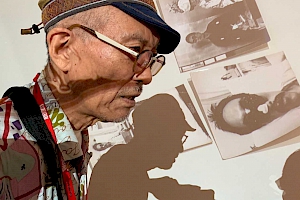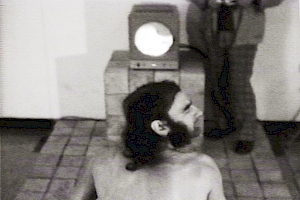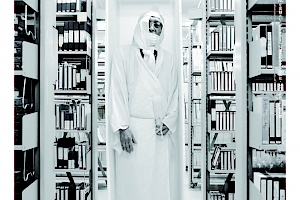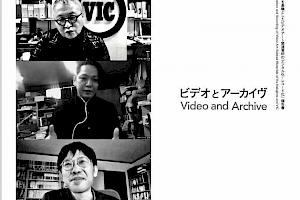Digitalization and Recording of Video Art Related Materials of Ko Nakajima and VIC
This project aims to reconsider the activities of media arts in Japan from the postwar period to present within the framework of “intermedia”, as well as to build a foundation for a clearer understanding of the history of media arts in Japan through the video art-related materials, which are located at the intersection of art and video history and various artistic activities of the same period, and represented here by Ko Nakajima and VIC.
Project Report (2020)
Project Report (2021)
2021
- Contact
Contact Hitoshi Kubo
pj.ca.oiek.c-tra@sevihcra
News and Activities
Events
Publication
● Support Program to Promote Archives of Media Arts 2020 “Digitalization and Recording of Video Art Related Materials of Ko Nakajima and VIC”
This project is a continuation of the Support Program to Promote Archives of Media Arts 2020 “Digitalization and Recording of Video Art Related Materials of Ko Nakajima and VIC”*1. It aims to reconsider the activities of media arts in Japan from the postwar period within the framework of “intermedia”*2 as well as to build a foundation for a clearer understanding of the history of media arts in Japan by focusing on the video art-related materials, especially the materials of Ko Nakajima *3 and VIC *4, which can be regarded as the intersection of art and video history and various artistic activities of the same period. This year, we continuously digitized, recorded, and listed videotapes of Nakajima and VIC as well as made a new list of videotapes preserved in Nakajima’s atelier. We also improved a list of his photographic materials. In addition, we conducted interviews to discuss the issues of video and archive.
In contrast with the classical forms of painting and sculpture, many art works created after the 1970s took unreproducible and ephemeral forms (performances/installations, etc.), so today they can be approached only through the remaining documents or related materials. Moreover, during this period, there were numerous types of works that connected old and new technologies and crossed over the frameworks of various genres. Although still photographic images were the main documentation medium of these ephemeral works (called installation), a lot of moving images of them were also taken by using video, whose importance as a recording device of time- based ephemeral activities is immeasurable. Such recordings are corresponding with video art. Furthermore, video art developed during this period did some experiments as a new medium of arts, created works with a similar focus of attention as experimental film, had an “intermedia” mechanism for connecting multiple art genres, recorded several works (events) in ephemeral forms, tried to construct new communicating technology, and criticized already-existing media technology. In other words, various important matters and issues related to media art were being developed within the framework of video art. In addition, as the development of the international research of “Mono-ha” shows, there is a growing interest in Japanese art activities after the late 1960s, and we can make a contribution to this worldwide trend by researching video art in Japan.
Among the materials related to video art, videotapes are valuable records of art works (events) in ephemeral forms and represent the fundamental issues of media art. However, many of them are poorly preserved, and due to the nature of the medium, they have deteriorated and become unplayable. The videotape materials of Ko Nakajima and VIC are no exception in that they have been molded, deteriorated. In addition, there are few available playback devices. Such a situation makes it difficult to identify the contents of these tapes. Thus, it is an urgent matter to take appropriate measures to preserve these tapes, digitize them, record and convert them into databases. Through digitizing, recording, and listing the video-related materials of Ko Nakajima and VIC, who were the key figures in video art after the 1970s, this project aims to give a tangible form to the works (events) in ephemeral forms and construct a history of media art from the perspective of video art.
● About “Video and the Archive” (2021)
Under the theme of “Video and the Archive”, we conducted interviews with Ko Nakajima (Jan. 25, 2022 | In- person), Kentaro Taki (Dec. 7, 2021 | Zoom), and Yosuke Nakagawa (Jan. 15, 2022 | Zoom). With Ko Nakajima, we mainly discussed the way of archival thinking in creation by focusing on his work My Life. With Kentaro Taki, we considered the main theme by discussing his activities, starting with the question why he organized the Videoart Center Tokyo. And with Yosuke Nakagawa, we discussed the main subject, starting with his research on the digitization of analog media and the inseparability between creation and preservation. These interviews revealed further issues that should be pursued and discussed in the future. For example, we should interview Japanese video artists on the theme of “video and archive”, have further discussions about contemporary video systems based on video archives, CATV, the history of video art, and the digitization of analog media, and so on. We hope to continue to work on these issues in the future.
Video and Ghost—A Conversation with Ko Nakajima
We discussed the theme of “Video and the Archive”, with Ko Nakajima (Jan. 25, 2022).
● About “Production Sites and Archive” (2020)
Initially, we planned to have an interview/discussion with video artists about “video archives” in a real space. However, due to the spread of COVID-19, we decided not to gather in person and changed it to an online interview/discussion via Zoom, to provide an opportunity to think about a series of issues. Interviews and discussions were held between five rooms connected via Zoom: Ko Nakajima (Gaienmae atelier), Ichiro Tezuka (Kichijoji VIC), Yosuke Nakagawa (Toride atelier), Yutaka Iida (study), and Hitoshi Kubo (Keio University Art Center Archive). First, by using Zoom, it is possible to record the activities of each production site with their central agents. Second, video documentation is possible. Third, while during an offline discussion participants need to gather at the same place, by using Zoom they can communicate with each other from different production sites simultaneously. This was an attempt to record and archive the discussion about recording and video archive itself. This interview/discussion consists of the following three blocks.
I. Production Sites and Archive
We connected Ko Nakajima (Gaienmae atelier), Ichiro Tezuka (Kichijoji VIC), Yosuke Nakagawa (Toride atelier), Yutaka Iida (study), and Hitoshi Kubo (Keio University Art Center Archive) via Zoom and recorded the activities at each production site, along with the central agents.
II. “Soft Museum” and Video Archive
In 1974, VIC representative Ichiro Tezuka and Fujiko Nakaya jointly conceived a “Soft Museum” project. With the main objective to establish a “fulfilling relationship between art and society,” the system consisted of three linked places: museum, city, and Soft Museum Center. They planned to convert various events to information through video and achieve interactive communication in which sender and receiver would take turns. The significant feature of this project is that they did not only focus on the works of art but the “total information about the artist’s life and process of creation”. Unfortunately, this concept was not realized, but we explored its possibilities to capture and respond to current issues of video.
III. Video Archives, CATV, and Current Video Streaming Services
Since the 1970s, both Nakajima and Tezuka, who were deeply involved with the video, have also individually immersed themselves in cable television. Nowadays, streaming services such as YouTube and Vimeo function as databases, and places that enable communication through video. How does the video function as a system in a world where any individual can run a semi-broadcasting station with pieces of basic equipment? What is the relationship between cable television’s attempt to connect the public and private spheres in a different style from mass media and the current video network centered around video streaming services? Which ideas of “Soft Museum” became possible and which didn’t? We discussed communication systems based on video documentation and the problems surrounding the process of archive.
- Digitisation and Documentation of Video Records of Performances and Exhibitions from 1970s Onward
- Digitalization and Recording of Video Art Related Materials of Ko Nakajima and VIC
- Cultural Narrative of a City
- “Architecture of Keio” Project
- Video Information Center and Documentation of Art in 1970s Japan
- #MuseumFromHome at KUAC
- SHOW-CASE project
- Research Project on Tokyo Biennale 1970
- Meeting Artists in Keio
- Genetic Engine
- Butoh: A Body Over the Edge
- Arts Management educational program
What's on
- Introduction to Art Archive XXVIII: In the Shadows: The Obscure World of Tatsumi Hijikata’s Choreography
- Papier Plié 02: Correspondences between Shuzo Takiguchi and Shusaku Arakawa/Madeline Gins — Margin and Blank
- The 40th Anniversary of Hijikata Tatsumi’s Death: Talking together about Hijikata Tatsumi
- Introduction to Art Archive XXIX: Yoshio Taniguchi in Keio
- Ambarvalia XV
- KUAC Cinematheque 4: 状況劇場「蛇姫様」上映会—単独性と反復または記録についてII




